TOP 30 Artists Setting Trends in Modern Art World
- 1. Jean-Michel Basquiat
- 2. Peter Doig
- 3. Christopher Wool
- 4. Rudolf Stingel
- 5. Mark Grotjahn
- 6. Richard Prince
- 7. Yoshitomo Nara
- 8. Keith Haring
- 9. Zeng Fanzhi
- 10. Damien Hirst
- 11. Adrian Ghenie
- 12. Anselm Kiefer
- 13. Albert Oehlen
- 14. Mark Bradford
- 15. Jeff Koons
- 16. Thomas Schütte
- 17. Zhang Xiaogang
- 18. John Currin
- 19. George Condo
- 20. Zhou Chunya
- 21. Sean Scully
- 22. Njideka Akunyili Crosby
- 23. Luo Zhongli
- 24. Günther Förg
- 25. Takashi Murakami
- 26. Miquel Barcelo
- 27. Liu Wei
- 28. Cecily Brown
- 29. Liu Xiaodong
- 30. Cindy Sherman
In a period characterized by continually changing trends, artists play a dual role as contributors to the dynamic panorama of contemporary artistic expression. This renders their creations especially significant within the framework of ongoing art movements. Drawing insights from Artprice's 2017 international report on the contemporary art market, we have meticulously assembled a compilation featuring TOP 30 modern artists. This varied assortment, which features anything from lively street art to abstract portraits of people, highlights the individual approaches taken by each artist in creating contemporary art.
1. Jean-Michel Basquiat
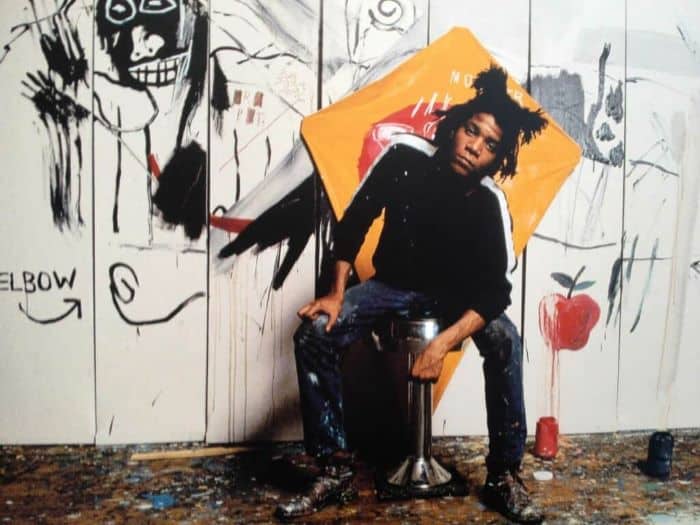
Jean-michel Basquiat
Jean-Michel Basquiat, widely regarded as one of the most iconic contemporary American painters, rose to prominence in the early 80's within New York’s Punk scene. His global recognition in the art world stems from groundbreaking works like his abstract facial paintings. Basquiat's "naïf" artistic style adeptly amalgamated various influences, creating collage-like pieces that often drew from his urban and African-Caribbean heritage. His contributions showcase how a counter-cultural art practice can transform into a widely accepted and celebrated form of art within commercial spheres. Notably, his abstract face paintings currently command some of the highest prices in today's art market, underscoring his lasting impact on the contemporary art scene. Basquiat's works, with its energetic and raw aesthetic, aligns with the principles of Neo-expressionism, and he is considered a key figure within this artistic movement. Neo-expressionism sought to revive and reinterpret the expressive and emotive qualities of traditional painting, incorporating bold colors, gestural brushstrokes, and intense subject matter.
2. Peter Doig

"White Canoe" Peter Doig
Peter Doig, a renowned contemporary artist, is associated with the Neo-Expressionist and Figurative movements, making a substantial impact on the art world. His distinctive style involves a unique blend of landscape, portraiture, and abstraction, characterized by vivid colors and dreamlike scenes. Born in Edinburgh in 1959, Doig spent his early years in Canada before settling in London. His artistic development unfolded against the backdrop of the dynamic art scenes in both Canada and the UK. Doig's paintings often evoke a sense of nostalgia and mystery, drawing inspiration from personal experiences and memories. His works are known for their atmospheric quality, with scenes that are both haunting and mesmerizing. One of his most famous pieces, "White Canoe," exemplifies his mastery in capturing the ethereal beauty of nature and the human experience. Over the years, Doig's art has garnered international acclaim, with exhibitions in major galleries and museums worldwide. His distinctive approach to painting, combining realism with a touch of abstraction, sets him apart as a leading contemporary artist. Peter Doig's contributions to the art world continue to shape and redefine the boundaries of contemporary painting, making him a key figure in the Neo-Expressionist movement. One of the reasons he makes our list of popular painters is because of the $11.3 million Sotheby's sale of his White Canoe in 2007, which at the time set a record for a living European artist.
3. Christopher Wool

Christopher Wool Untitled (The Show Is Over)
Christopher Wool is associated with the contemporary art movement known as Neo-Conceptualism. He gained prominence in the 1980s and is recognized for his distinctive approach to painting. Wool's art style is characterized by the use of text, often stenciled or painted with industrial materials, on large-scale canvases. His works often feature bold, black letters or phrases that create a visual impact. Early influences include street art and graffiti, which contribute to the raw and urban aesthetic in his works. He was part of the dynamic art scene in downtown New York City during the 1980s, collaborating with artists like Jean-Michel Basquiat. Wool's paintings often embody a sense of ambiguity and open interpretation, encouraging viewers to question the relationship between text and visual representation. Notable pieces such as "Apocalypse Now" ("Sell the house sell the car sell the kids") and "If You" ("If you can't take a joke you can get the fuck out of my house") achieved remarkable success, fetching prices ranging from $15 to 30 million at prestigious auction houses like Christie's.
4. Rudolf Stingel

Rudolf Stingel
Residing in New York, the Italian artist Rudolf Stingel has been a prominent figure in the contemporary art scene since the 1980s. Associated with the contemporary art movement, Rudolf Stingel is frequently considered a key player in the field of Conceptual and Neo-Conceptual Art. Stingel's art style is characterized by a multidisciplinary approach, incorporating elements of painting, installation, and conceptual art. A prominent feature of his work is the use of unconventional materials and techniques, such as silver insulation, carpet, and styrofoam. At the core of Rudolf Stingel's artistic exploration lies a meticulous scrutiny of the painting medium, wherein he actively challenges conventional notions of authenticity, hierarchy, meaning, and contextual significance. The prices of Stingel's artwork significantly increased after his 2007 Whitney Museum exhibition in New York.
5. Mark Grotjahn

Mark Grotjahn
Mark Grotjahn is an American contemporary artist known for his distinctive and vibrant paintings. Born in 1968 in Pasadena, California, Grotjahn has gained recognition for his unique approach to geometric abstraction and exploration of color theory. Grotjahn's artistic style often involves intricate, multi-colored compositions that radiate from a central point, creating a dynamic and visually captivating effect. He is associated with the contemporary art movement and has been influential in reinvigorating interest in abstract painting.
Throughout his career, Grotjahn has exhibited a commitment to pushing the boundaries of traditional painting. His works are characterized by a sense of movement and optical illusion, as the geometric patterns seem to shift and transform when viewed from different angles. The artist's success has been marked by numerous solo exhibitions at prominent galleries and museums worldwide. His contributions to contemporary art have left a lasting impact, with his works held in major public and private collections. The modern painting style of Mark Grotjahn is believed to have a subtle dialogue with the artistic sensibilities of Bridget Riley, Barnett Newman, and Kazimir Malevich. In his artistic attempts, Grotjahn often explores the idea of the vanishing point in perspective, using bright and brilliant colors.
6. Richard Prince
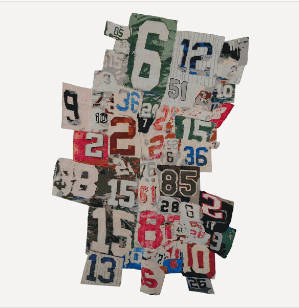
Richard Prince 1-234-567-8910
Richard Prince stands out among contemporary artists for his adept use of appropriation. Known for repurposing mass-media images, Prince engages in a deliberate exploration that challenges and reshapes conventional ideas surrounding authorship and ownership. Primarily associated with the appropriation art movement, Prince gained prominence in the 1980s by rephotographing advertisements and presenting them as his own artwork. This approach challenged notions of authorship and originality, becoming a hallmark of his artistic style. Prince's work extends beyond rephotography to include painting, drawing, and other mediums. He is known for exploring themes related to American popular culture, mass media, and the concept of celebrity. Throughout his career, Prince has been a controversial and influential figure in the art world. His series like "Cowboys," "Nurse Paintings," and "Joke Paintings" have garnered attention for their cultural critique and subversion of artistic conventions. Back in 2005, his piece "Untitled (Cowboy)" made history by being the first re-photograph to fetch over $1 million at auction. In more recent times, Prince has turned his attention to Instagram, appropriating posts from multiple young women and selling them for significant sums. The resulting controversies and legal battles, in an unusual twist, are woven into the fabric of Prince's artistic expression.
7. Yoshitomo Nara

Yoshitomo Nara Miss Spring
Known for his distinctive style that merges elements of pop culture, manga, and fine art, Nara has left an indelible mark on the global art scene. While Yoshitomo Nara's work does share some thematic and stylistic elements with the Pop Art movement, particularly in its incorporation of popular culture and playful aesthetics, he is more closely associated with the Superflat movement.
Nara's art often features deceptively simple, childlike characters that carry an underlying sense of introspection and rebellion. Nara's international acclaim soared in the 1990s, and he became a prominent figure in the Japanese contemporary art movement. His works, while appearing cute and approachable, delve into deeper themes of identity, isolation, and the complexities of human emotion. With exhibitions held worldwide and a permanent collection at the MoMA in New York, Yoshitomo Nara's impact extends far beyond the borders of Japan.
8. Keith Haring

Keith Haring
Keith Haring was an American artist and social activist known for his iconic and instantly recognizable visual language. Haring's art is often associated with the Pop Art and street art movements. His work is characterized by bold lines, vivid colors, and simple, yet powerful, symbolic imagery. Haring's iconic motifs, including radiant babies, barking dogs, and dancing figures, convey messages of love, unity, and activism. Haring emerged as a prominent figure in the New York City art scene during the 1980s. One of Haring's most significant contributions to the art world is his use of public spaces as a canvas for his graffiti-inspired artwork. His subway drawings and public murals became a form of accessible and democratic art, breaking down traditional barriers between high and low culture. At auctions, Haring's pieces command significant prices, with some fetching up to approximately $6 million. This sustained demand underscores the lasting impact of Haring's iconic and socially resonant artwork on the contemporary art market.
9. Zeng Fanzhi
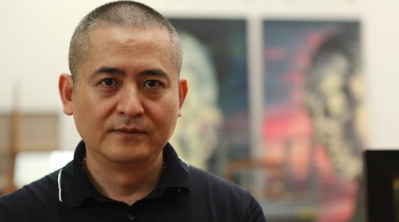
Zeng Fanzhi
Zeng Fanzhi, shaped by his upbringing in China during the Cultural Revolution, channels his experiences into a profound artistic narrative. His creations grapple with the challenging history of modernity and reflect on the isolation and unpredictability of contemporary life. Notably, in the 1990s, Fanzhi gained acclaim for his poignant Hospital and Meat painting series, which encapsulates the struggles and complexities of the human condition. Fanzhi's distinctive artistic fingerprint is characterized by an expressionistic style, featuring figures with enlarged heads and exaggerated features. His portfolio also includes abstract paintings of faces, showcasing the versatility of his creative vision. The pinnacle of Fanzhi's success came in 2013 when his artwork "The Last Supper" achieved a groundbreaking sale at Sotheby's Hong Kong, fetching an unprecedented $23.3 million. This remarkable feat set a record for the highest price ever achieved for a piece by an Asian modern artist at auction, solidifying Zeng Fanzhi's position as a trailblazer in the contemporary art world.
10. Damien Hirst

Damien Hirst Beautiful Happy Vortex Whirl Painting (With Butterflies)
Damien Hirst stands out as a leading figure among the Young British Artists, a collective that exerted significant influence over the UK contemporary art scene in the 1990s. Regarded as the wealthiest living artist in the UK, Hirst achieved an unparalleled milestone in 2008 by setting a record for a solo artist auction. His entire show, "Beautiful Inside My Head Forever," commanded an astonishing $198 million. Hirst's artistic oeuvre is most notably recognized for his provocative series featuring deceased animals preserved in formaldehyde. This collection, often regarded as both controversial and compelling, exemplifies his penchant for exploring themes of life, death, and the boundaries between art and science. Additionally, his iconic creation, "For the Love of God," a diamond-encrusted skull, stands as a symbol of opulence and mortality.
11. Adrian Ghenie

Adrian Ghenie
Adrian Ghenie, hailing from the influential Cluj School in Romania, is a distinguished artist whose canvases burst with intricate textures and vibrant hues. His expressive imagery delicately treads the line between clarity and decay, creating a visual language that captivates the viewer. Rooted in the Cluj School tradition, Ghenie's work intricately weaves together personal and collective fears, traumas, and memories, offering a poignant exploration of the haunting shadows cast by 20th-century European history. Renowned for his abstract paintings of faces, Ghenie's art has recently soared in demand, with prices skyrocketing and a growing list of eager private buyers awaiting the chance to acquire his creations. The confluence of factors contributing to his immense popularity on the contemporary art market includes a robust appetite for painting, Ghenie's intentionally limited output, scarcity of available masterpieces, an accessible price point relative to the upper echelons of the market, and the increasing influence of affluent Asian collectors.
12. Anselm Kiefer
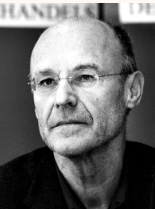
Anselm Kiefer
Anselm Kiefer, born in Germany in 1945, is a prominent contemporary artist affiliated with the Neo-Expressionist movement, renowned for his profound exploration of history, mythology, and existential themes. Kiefer's artistic journey encompasses various mediums, including painting, sculpture, and installations, reflecting his deep engagement with both personal and collective narratives. His early works, characterized by the incorporation of unconventional materials like straw, ash, and lead, grapple with Germany's complex post-war identity. Kiefer's monumental installations, often addressing themes of alchemy and mysticism, invite viewers to confront the weight of history and the transformative power of art. Kiefer's art evolves across diverse subject matter, from German history and Norse mythology to broader existential reflections. His epic-scale sculptures and abstract paintings of faces serve as intricate references to National Socialist architecture, post-Holocaust poetry, and Cold War politics. The artist's use of materials, including burned books, ashes, and thorny branches, further enriches the symbolic depth of his creations. The sale of Kiefer's 1983 painting "To the Unknown Painter" brought in $3.6 million, setting a record for Christie's to sell art globally in 2011. This milestone underscores the enduring significance and market demand for Anselm Kiefer's art, solidifying his position as a pivotal figure in the contemporary art landscape.
13. Albert Oehlen

Albert Oehlen
Albert Oehlen, a German artist, rose to prominence in the 1980s within Hamburg's burgeoning art scene. Known for his distinctive approach, Oehlen employs impulse and eclecticism as guiding principles in his work. His creative process often begins with a predefined set of rules or structural limitations, and he utilizes a diverse array of tools, including his fingers, brushes, collage techniques, and computers. In recent years, there has been a notable surge in the demand for Albert Oehlen's art, elevating him into the luxury echelons of the art market. This heightened interest prompts speculation about whether this shift will impact the reception of his renowned modern art. As his work enters the exclusive realm of the luxury art market, questions arise regarding potential changes in the perception and interpretation of Oehlen's influential contributions to contemporary art.
14. Mark Bradford

Mark Bradford Studio Los Angeles
Mark Bradford is a prominent figure in contemporary art, aligned with a movement that transcends traditional boundaries. His artistic style, rooted in modern abstraction and a deep connection with urban communities, manifests through a diverse range of mediums, including mixed-media collages, public art installations, and video projects. Bradford's works stand out for their dynamic and multifaceted nature, seamlessly merging elements of high art with popular culture. His distinctive approach involves navigating uncomfortable and confrontational societal topics, creating a space for critical dialogues on systemic inequalities and contemporary socio political challenges. Whether through collage or large-scale installations, Bradford's creations reflect a deep engagement with the complexities of the modern world. In addition to his individualistic style, Bradford's work often references urban environments and the diverse experiences of their inhabitants. This integration of real-world elements adds layers of depth and authenticity to his art, creating a unique and impactful body of work that resonates globally. In 2018, Mark Bradford crafted an immensely discussed exhibition adjacent to the U.S. pavilion Venice Biennale. This thought-provoking installation drew inspiration from the Virginia plantation once owned by Thomas Jefferson, delving into pressing issues such as the ascent of Trump, instances of police violence, and the Black Lives Matter movement.
15. Jeff Koons
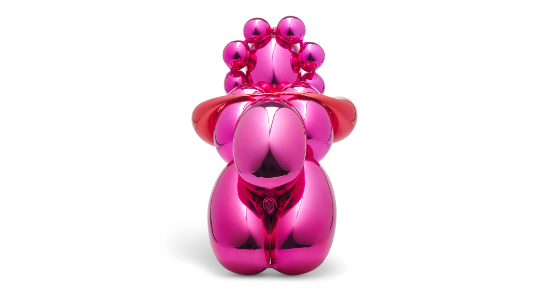
Jeff Koons - Balloon
Jeff Koons is a celebrated American contemporary artist renowned for his provocative and iconic works that span various mediums, including sculpture, painting, and installations. Born in 1955, Koons emerged as a prominent figure in the 1980s, part of the Neo-Pop movement. His artistic style often involves the appropriation of popular culture and everyday objects, elevating them to the status of high art. One of Koons' most famous and controversial works is "Balloon Dog," a large-scale sculpture made of stainless steel with a mirror-polished finish. This piece, part of his "Celebration" series, is both playful and thought-provoking, embodying the artist's fascination with childhood and the ephemeral nature of joy. Throughout his career, Jeff Koons has faced both praise and criticism for his work, which often pushes the boundaries of taste and challenges conventional artistic norms. His pieces, such as "Rabbit," "Puppy," and "Tulips," have become iconic symbols in the realm of contemporary art. Koons' influence extends beyond the art world; he is known for his collaborations with luxury brands and his engagement with popular culture.
16. Thomas Schütte

Thomas Schütte - Photo Albrecht Fuchs
Thomas Schütte, born in 1954 in Oldenburg, Germany, is a highly regarded contemporary artist known for his diverse and innovative body of work. Spanning various mediums, including sculpture, drawing, printmaking, and architecture, Schütte's artistic practice defies easy categorization. Schütte rose to prominence in the 1980s as part of the generation of German artists that emerged after the post-war period. He is associated with the New Sculpture movement, which sought to break away from the minimalist and conceptual art prevalent at the time. One of Schütte's notable series is "United Enemies," which features small, enigmatic figures engaged in ambiguous interactions. These sculptures embody a sense of psychological tension and narrative complexity, inviting viewers to interpret their meaning. In addition to his sculptures, Schütte has ventured into architectural projects, including the design of public buildings. His architectural works reflect a commitment to exploring spatial relationships and engaging with the built environment in innovative ways. With a significant international presence, Schütte's contributions continue to shape the discourse around sculpture and contemporary artistic practice.
17. Zhang Xiaogang
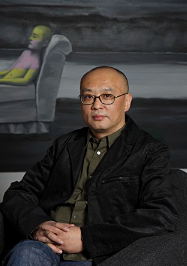
Zhang Xiaogang
Zhang Xiaogang gained international acclaim for his compelling and emotionally charged paintings, which often explore themes related to memory, identity, and the collective experiences of the Chinese people. One of Zhang Xiaogang's most notable series is "Bloodlines: The Big Family," which features portraits of stylized figures, typically presented against a monochromatic background. The series explores the intricate relationship between individual and collective identity, reflecting the socio-political changes in China's modern history. It was first launched in the early 1990s. Zhang's work is deeply rooted in Chinese history and the impact of the Cultural Revolution on individuals and families. The use of red lines on the figures' faces in the "Bloodlines" series symbolizes connections and relationships, emphasizing the shared history and interconnectedness of people. Zhang's exploration of memory and identity resonates not only with Chinese audiences but also with art enthusiasts around the globe, contributing to the rich tapestry of contemporary artistic expression.
18. John Currin
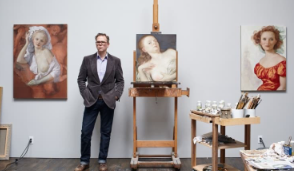
John Currin
John Currin is an American painter renowned for his distinctive approach to figurative art, blending classical techniques with a contemporary and often provocative sensibility. Born in 1962 in Boulder, Colorado, Currin emerged as a prominent figure in the art world during the 1990s.
His work often features exaggerated and idealized figures, drawing inspiration from Old Master paintings while challenging conventional notions of beauty and taste. One of Currin's notable series includes his depictions of idealized women, often with an element of surrealism or humor. The artist's ability to navigate complex themes of desire, beauty, and societal expectations has earned him recognition and critical acclaim. Currin’s paintings, while rooted in traditional techniques, often subvert expectations and confront contemporary attitudes toward gender, sexuality, and aesthetics. As a leading figure in contemporary figurative art, Currin's paintings challenge viewers to reconsider established norms and engage in a dialogue about the complexities of representation and identity in the 21st century.
19. George Condo
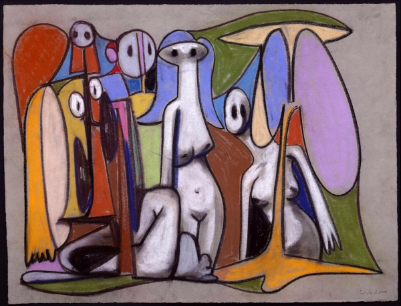
George Condo Naked Ghosts Pulpo Gallery
George Condo, born in 1957, stands as a prominent American contemporary artist celebrated for his impactful contributions to the art world. Known for his provocative and distorted figurative art, Condo's work defies conventional norms in portraiture. His distinctive style combines classical techniques with a surreal aesthetic, creating a visual language that engages with the complexities of the human experience. Condo's notable series, "The Mental States," explores the multifaceted nature of human emotions through vibrant colors, bold brushstrokes, and distorted facial features. This body of work exemplifies his ability to evoke a sense of unease and ambiguity in his compositions. Associated with the Neo-Expressionist movement, Condo has left a lasting mark on the contemporary art scene. Beyond the canvas, he has collaborated with musicians, including designing album covers for Kanye West's "My Beautiful Dark Twisted Fantasy," showcasing his influence on the intersection of art and popular culture. With international acclaim, Condo's works are featured in major museums and galleries globally.
20. Zhou Chunya

Zhou Chunya
Zhou Chunya, born in 1955 in Chongqing, China, is a prominent contemporary artist recognized for his vibrant and expressive paintings. Zhou is renowned for his "Green Dog" series, where he depicts a green German Shepherd in various settings. This iconic motif symbolizes the artist's exploration of individuality, self-expression, and the intersection between the personal and the collective. The bold use of color and dynamic brushstrokes in Zhou's works infuse energy into his compositions. Beyond his celebrated canine series, Zhou Chunya has experimented with various themes and styles, including his "Peach Blossom" and "Tao Hua Yuan" series, which explore utopian landscapes and reflect on Chinese cultural traditions. His works, characterized by a harmonious blend of traditional Chinese influences and contemporary aesthetics, continue to captivate audiences worldwide.
21. Sean Scully
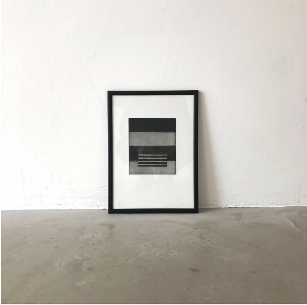
Sean Scully
Sean Scully is an Irish painter who works with engraving, sculpture, and photography. Scully's art is characterized by a unique interplay of geometric forms, rhythmic patterns, and a nuanced exploration of color and texture. The artist employs stripes not merely as visual elements but as carriers of emotional weight and narrative. His "Wall of Light" series, characterized by large-scale, multi-paneled paintings, exemplifies this approach. The series reflects a profound engagement with light, color relationships, and the potential for abstraction to convey complex emotional states. Scully's impact extends beyond his studio practice; he is also an influential writer and lecturer on contemporary art. His works are housed in major museums and collections worldwide, underscoring his enduring influence on the trajectory of abstract art in the late 20th and early 21st centuries.
22. Njideka Akunyili Crosby
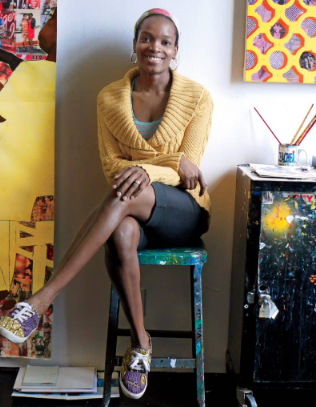
Njideka Akunyili Crosby
Njideka Akunyili Crosby, born in Nigeria, in 1983 is known for her exceptional contributions to figurative painting. Currently based in Los Angeles, Akunyili Crosby has gained international recognition for her unique artistic style that fuses traditional Nigerian influences with Western art techniques. Akunyili Crosby's work often revolves around the exploration of her cultural identity, delving into the complexities of being an African woman living in the diaspora. The use of collage techniques, photo transfers, and a vibrant color palette adds depth and dimension to her paintings. One of her notable series is the "Super Blue Omo," which captures intimate moments within her family, often referencing historical and political events in Nigeria. Her ability to seamlessly blend personal experiences with broader socio-political commentary has garnered widespread acclaim. Through her innovative approach to visual storytelling, Akunyili Crosby continues to shape conversations around cultural hybridity, migration, and the complexities of contemporary identity. Her artwork increased in value from about $100,000 to over $3 million, proving she is one of the most well-known artists working today.
23. Luo Zhongli
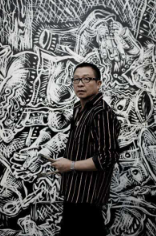
Luo Zhongli
Chinese artist Luo Zhongli is a distinguished contemporary Chinese artist renowned for his significant contributions to the Chinese art scene. One of Luo Zhongli's most famous works is the iconic painting "Father," which gained international recognition. Completed in 1980, this portrait captures the artist's father in a moment of quiet reflection, embodying a profound and universal sense of humanity. The work is considered a pivotal piece in the transition from the more politically charged art of the Cultural Revolution to a more introspective and humanistic approach.
Luo Zhongli's art often explores themes of rural life, family, and the human condition. His paintings are characterized by meticulous attention to detail, earthy tones, and a narrative quality that captures the essence of everyday life in China. His focus on portraying the dignity and resilience of ordinary people has made him a significant figure in Chinese contemporary art.
24. Günther Förg

Günther Förg
Günther Förg was a German contemporary artist recognized for his diverse and influential contributions to the realms of painting, sculpture, and photography. Förg's paintings often featured bold geometric shapes, exploring the interplay between color and form. Beyond painting, Förg ventured into photography, sculpture, and architectural installations. Förg's architectural photographs, capturing the interplay of light and shadow, are particularly noteworthy for their nuanced compositions. His ability to navigate diverse artistic approaches and engage with the broader cultural and historical context solidified his position as a significant figure in German contemporary art. Günther Förg's works are held in prominent collections worldwide, and his impact on the trajectory of post-war European art remains a subject of study and admiration. His legacy is marked by a commitment to artistic exploration and a constant evolution that mirrors the dynamic changes in the art world during the latter half of the 20th century.
25. Takashi Murakami
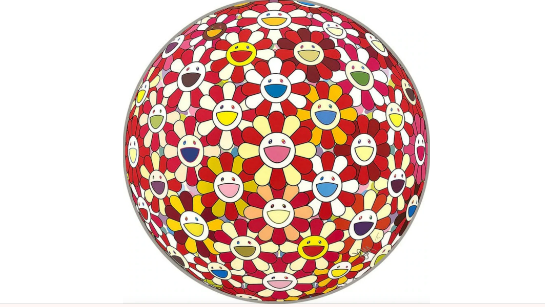
Takashi Murakami Koi/red-crowned Crane Vermillion
Takashi Murakami's most famous work is arguably "Superflat," a term he coined that defines both an art movement and a distinctive aesthetic. "Superflat" merges traditional Japanese art forms with contemporary pop culture, characterized by flat, two-dimensional imagery. His iconic smiling flowers and colorful, anthropomorphic characters exemplify this style. Murakami is a leading figure in the Superflat movement, which critiques and challenges distinctions between high and low art. The movement draws inspiration from traditional Japanese art, manga, and anime, showcasing a unique fusion of historical and contemporary influences. What sets Murakami apart is his ability to transcend the confines of the art world. His collaboration with Louis Vuitton on a collection of handbags and accessories brought his vibrant art into the realm of high fashion, reaching a global audience. This fusion of art, commerce, and popular culture has made Takashi Murakami a cultural phenomenon and a trailblazer in contemporary art.
26. Miquel Barcelo

Miquel Barcelo
Miquel Barceló, a prominent Spanish contemporary artist celebrated for his diverse and innovative body of work. His renowned painting "Gran Elefant dins una sala" (Big Elephant in a Room) is one of his most famous creations, featuring an expressive and dynamic depiction of an elephant rendered in a rich, earthy palette. Barceló's distinctive style encompasses a wide range of mediums, including painting, sculpture, ceramics, and installations. He gained international acclaim for his ability to merge traditional and contemporary techniques, often drawing inspiration from his Mediterranean roots. His work reflects a deep engagement with nature, culture, and the human experience. A notable characteristic of Barceló's art is its tactile and visceral quality. Whether working on large-scale murals or intricate ceramic pieces, he displays a profound connection to the material and a commitment to pushing the boundaries of artistic expression. This dedication to experimentation has positioned Barceló as a dynamic force in the global art scene.
27. Liu Wei
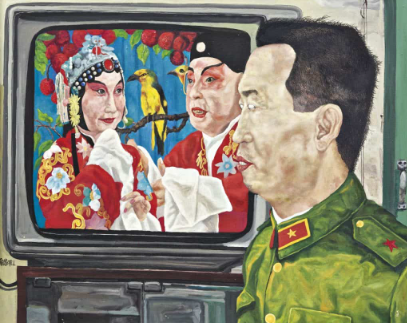
Liu Wei
Chinese modern artist Liu Wei, who was born in Beijing, is well-known for his dynamic and multifaceted style. One of his most notable works is the "Purple Air" series, featuring densely layered and textured canvases that challenge traditional notions of painting. A distinctive feature of Liu Wei's art is his constant experimentation with materials and mediums. Liu Wei is associated with the Post-Sense Sensibility movement, a Chinese avant-garde art movement of the late 1990s that challenged conventional artistic norms. His work often engages with urbanization, globalization, and the evolving dynamics of contemporary Chinese society. Internationally acclaimed, Liu Wei's art transcends cultural boundaries, captivating audiences with its bold exploration of form, color, and societal themes.
28. Cecily Brown
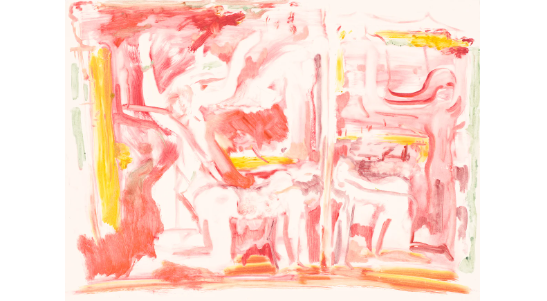
Cecily Brown Untitled
Cecily Brown, a prominent artist in the field of abstract expressionism, was born in London and is well-known for her expressive and gestural paintings. One of Brown's most notable works is "The Girl's Got a Reputation" (2002), which exemplifies her distinctive style. Characterized by vibrant and layered brushstrokes, her compositions evoke a sense of movement and fluidity. The interplay of color and form in her works often draws comparisons to both the abstract expressionist and the Baroque traditions. Brown's art is marked by a unique balance between abstraction and figuration, as she skillfully navigates the realms of the recognizable and the suggestive. Her exploration of the human form, often imbued with a sense of eroticism, adds depth and complexity to her paintings. Her ability to infuse her art with both emotional intensity and intellectual depth has solidified Cecily Brown's place as a significant and influential painter in the contemporary art world.
29. Liu Xiaodong

Liu Xiaodong
Liu Xiaodong, widely regarded as one of the most accomplished painters in art history, is celebrated for his mastery of brushwork, vibrant color palette, and meticulous forms. Embracing cropped framing, unconventional perspectives, and a nuanced use of colors to amplify emotional depth, he introduced a distinctive and innovative dimension to his art. Liu is noteworthy for his dedication to painting his subjects in their natural settings. He has traveled to depict common people in difficult places including rural China, Tibet, and Israel-Palestine. His contributions have left a lasting impact on the global art scene, bridging cultural divides through the universal language of visual storytelling.
30. Cindy Sherman
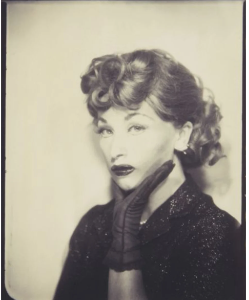
Cindy Sherman Untitled (Lucille Ball)
American artist Cindy Sherman rose to prominence through her renowned series "Untitled Film Stills" (1977-1980), where she ingeniously portrayed various female archetypes from 20th-century pop culture in self-portrait photographs. Her art serves as a profound exploration of women's roles across different historical periods and in contemporary society, drawing intriguing parallels with the abstract paintings of faces by some of her contemporaries. A hallmark of Sherman's approach is the deliberate ambiguity within her work, encouraging viewers to bring their interpretations to the forefront. In a manner akin to several modern artists, Sherman deliberately allows her work to be open to interpretation, inviting viewers to engage in their own narratives. Widely perceived as a feminist symbol, her body of work contributes significantly to the ongoing discourse on gender and societal expectations.
No Comments Yet...